Fix: 0x80073CFA Error When Uninstalling Apps on Windows
Several Windows users are reporting that whenever they try to uninstall an app that they initially installed via the Windows Store, the operation gets interrupted via the Error Code (0x80073CFA). Affected users experience this error with every app they attempt to uninstall. The issue is documented to occur on both Windows 10 and Windows 11.
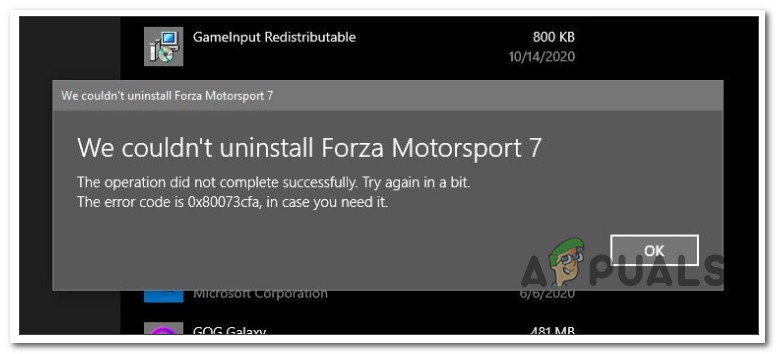
After investigating this particular issue thoroughly, we realized that several different underlying causes might directly or indirectly cause this issue. Here’s a list of culprits that you should be aware of:
- Common Windows Store Inconsistency – If you’re only encountering this issue while attempting to delete or uninstall UWP (Universal Windows Platform) applications, there’s a massive chance that this problem occurs due to a specific Windows Store inconsistency. In this case, the quickest way to fix the issue is to run the Windows Store Troubleshooter and apply the recommended fix.
- Corrupted Windows Store Cache – As it turns out, another scenario in which you might encounter this type of error is when the uninstallation component is actually inhibited by some type of corruption stored inside the cache folder of Windows Store. If you’re dealing with this scenario, the first thing you should try is to perform a wsreset.exe procedure in order to clean the cache folder.
- Windows is outdated – According to Microsoft, the’ve already patched this issue with a series of hotfixes released on every distribution channel (on both Windows 10 and Windows 11). Before going into more advanced troubleshooting methods, make sure that you have these hotfixes installed by installing every pending update.
- Microsoft Store is outdated – As a security measure, Microsoft will not let you carry on with certain sensitive operations (such as uninstalling a system-related UWP app) if your Microsoft Store is outdated. To make sure this isn’t the reason why you’re experiencing the 0x80073CFA error, make sure you install every pending update for Microsoft Store.
- System file corruption – If you’re experiencing a similar problem when you’re attempting to uninstall a UWP app, there’s a big chance you’re dealing with some kind of system file corruption. If this scenario si applicable, you should start by deploying SFC and DISM scans. If this still doesn’t fix the issue, consider going for a clean install or repair install procedure.
- Windows account doesn’t have admin rights – Keep in mind that you might expect to deal with the 0x80073CFA in a situation where the Microsoft account that you’re using doesn’t have administrative privileges. If this scenario is applicable, you can fix the problem by creating an admin account via CMD and performing the uninstallation while you are signed into it.
- Full version of the game is present – As it turns out, you might expect to encounter this particular version if you are attempting to uninstall a demo of a game that you already own. This is a Microsoft Store glitch that prevents you from uninstall it. However, you can get around it by navigating to the location of the game demo and deleting it manually.
- Incorrect Powershell command – If you get this error while attempting to uninstall W10 packages from your Windows 11 computer via Powershell, you should double-check your syntax. We’ve provided the full instructions on how to uninstall unnecessary W10 packages via an elevated Powershell terminal.
Now that we have gone over every potential fix that might be responsible for this particular issue, let’s go over a series of fixes that other affected users have successfully used to get to the bottom of this issue.
1. Run the Windows Store Troubleshooter
There is a very good possibility that this issue arises because of an unique Windows Store discrepancy if you’re only experiencing it when trying to delete or uninstall UWP (Universal Windows Platform) programs. Running the Windows Store Troubleshooter in this situation and making the suggested remedy are the fastest ways to resolve the problem.
Running the Windows Store Apps troubleshooter was occasionally the answer that gave the Microsoft Store proper functionality again and allowed users to uninstall UWP apps without seeing the same 0x80073CFA error.
Despite the fact that both Windows 10 and Windows 11 allow this approach, the steps to get there are significantly different for each. On Windows 10, if you run into any difficulties, you may find step-by-step instructions online.
The Windows Store Apps troubleshooter option can be found by going to the Troubleshoot section of Windows Settings. When you select it, it will immediately identify the underlying cause of the mistake and offer a solution.
Follow these easy steps to use Windows 11’s troubleshooter for Windows Store Apps:
- Your first action must be to open the Windows Settings. After clicking the Windows key + R, type “ms-settings:” in the Run dialog box to open the Settings. You can also open them immediately from the taskbar or by pressing the Windows key + I.
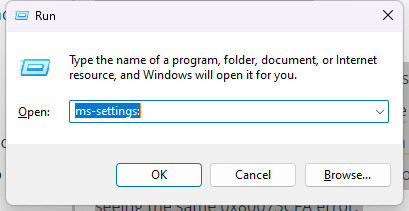
Open the Settings menu - After accessing Windows Settings, look for System in the list on the left side of the screen. When you find this location, click on it.
- Next, move over to the right-hand section, locate Troubleshoot in the System section by scrolling down and clicking on it.

Accessing the Troubleshoot menu - You must now select Other troubleshooters to proceed to the next stage.
- After entering the Other troubleshooters section, scroll down to the bottom of the screen to see Windows Store Apps.
- When you see it, click Run to open the Windows Store Apps troubleshooter.

Access the Windows Store apps troubleshooter - When you have done troubleshooting, follow the instructions provided to complete the process.
- Repeat the uninstallation that was previously failing with the 0x80073cfa after you’re done, and check to see if the system file error has been resolved.
If the issue still exists, try the following possible fix below.
2. Make sure Windows is up to Date
Microsoft claims to have already corrected this problem with a number of hotfixes made available across all channels of distribution (on both Windows 10 and Windows 11). Install all pending updates to ensure that you have these hotfixes installed before attempting more complex troubleshooting techniques.
As it turns out, if your operating system is missing a vital component of the Windows Update architecture, you might not be able to remove UWP apps.
This can be fixed by opening Windows Update, checking to see if any updates are available, and installing them if they are. Your computer’s settings are where you’ll find the Windows Update options.
If you’re not sure how to check if the most recent Windows updates have been installed, here is the complete procedure:
- Open the Windows Settings first. One of the easiest ways to complete this activity is by pressing the Windows key + R, typing “ms-settings:,” and then pressing Enter to open a Run dialog box.

Open the Settings menu - In the Windows Settings window, use the menu on the left to scroll down until you locate Windows Update. Click on it when you locate it.

Access Windows Update - Once you are in the Windows Update, you should be able to see the Check for updates button. The scan won’t be available immediately. Select Install to begin if an immediate update installation is required.
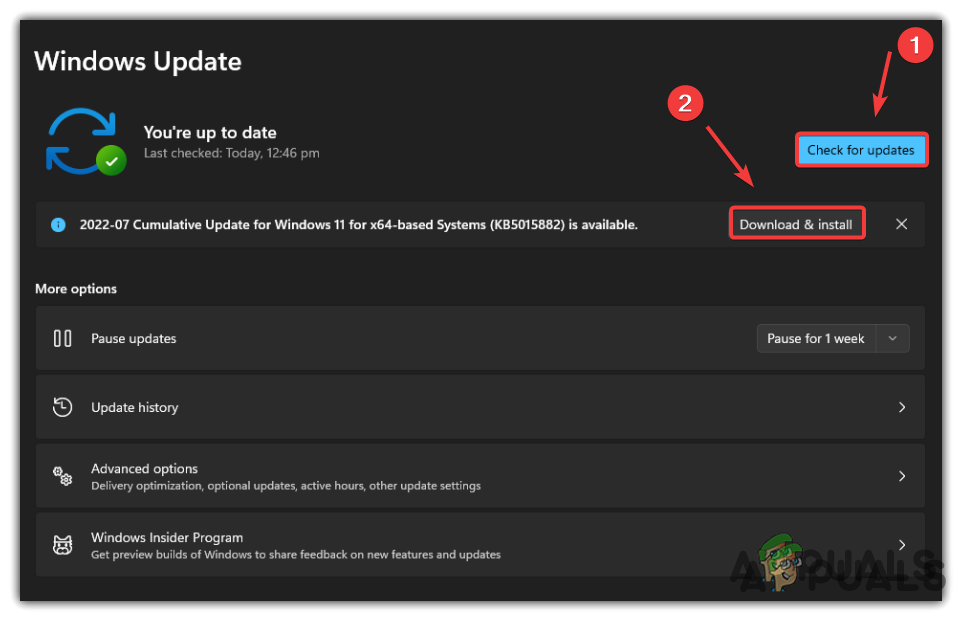
Checking for Updates and installing them - To make sure the updates are correctly deployed, restart your computer after they have been installed.
- Try the uninstallation once more to see if the issue has been fixed.
If you’re still experiencing the same 0x80073CFA error code, move down to the next method below.
3. Make sure Windows Store is up to Date
If your Microsoft Store is out-of-date, Microsoft will prevent you from performing some sensitive tasks (such deleting a UWP app that is tied to the system) as a security protection. Make sure to apply all pending Microsoft Store updates to make sure this isn’t the cause of your 0x80073CFA error.
You only need to open the Microsoft Store and head to the Library to accomplish this. There, you can check for updates, and they will be installed if any are discovered.
Here are the steps that will demonstrate how to do it in case you don’t already know how:
- To open the Microsoft Store, open a Run dialog box by hitting Windows key + R, typing “ms-windows-store:” into the search bar, and then pressing Enter. The choice is yours, and the Microsoft Store can also be accessed from the taskbar or other locations.
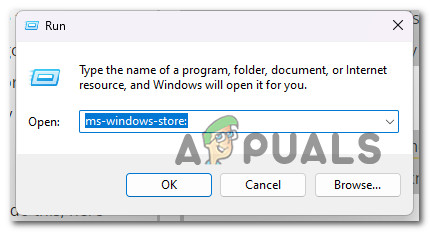
Access the Microsoft Store - You must open the Library after the Microsoft Store opens on your screen. In the bottom left corner of the screen, select the icon.
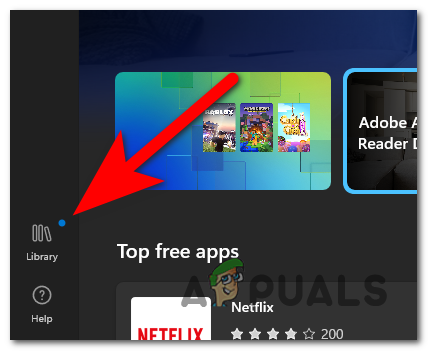
Accessing the Library of Microsoft Store - Once within the Library, select the Get updates icon on the right side to see whether any of your programs, including the Microsoft Store, have updates available.

Checking for App udpates - If any updates are discovered to be available, they will immediately begin to download.
- After the updates have been installed, try to install more programs that you were previously unable to install to check if the error still occurs.
Continue to the next technique below if you have updated your Microsoft Store but are still unable to install apps on it.
4. Reset the Windows Store Cache
It turns out that another situation when you could run into this issue is when the uninstaller is really prevented from working by some sort of corruption that is kept in the cache folder of the Windows Store. If you find yourself in this situation, your first line of defense should be to run a wsreset.exe process to clear the cache folder.
Note: Corrupted data that has accumulated in the Windows Store’s cache is one instance that is routinely neglected. Several Windows 11 users with whom we have previously worked through similar issues have noted that restarting the entire Windows Store component is effective.
It turns out that a type of corruption that prohibits your PC from making connections with Microsoft servers and your integrated UWP store could possibly be the cause of this issue. The bulk of the time, this problem is caused by temporary files that are stored in the cache folder.
This type of problem frequently occurs following an unanticipated machine failure or when the security scanner ends up quarantining particular items. Infrequent but possible causes of the “Sign in with Your Microsoft Account to Continue App Experience” issue include faulty upgrades.
Restarting Windows Store and all associated components, according to many Windows users who were having the same problem, resolved it.
The quickest method is to launch an elevatex Command Prompt window and issue the wsreset.exe command from there. This is how:
- Press the Windows key + R to open the Run dialog box. To open an administrator Command Prompt, type “cmd” into the text box and press Ctrl + Shift + Enter.
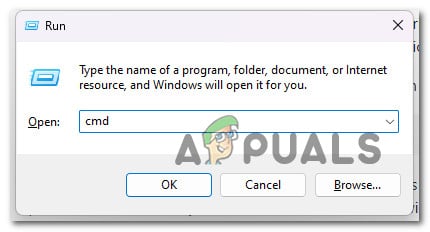
Open a CMD window - When prompted by UAC (User Account Control), select Yes to give admin access.
- After you’ve managed to launch the elevated Command Prompt, enter the following command to reset the Windows Store and its dependencies.
wsreset.exe
- After the command has been successfully run, restart your computer to see if the issue has been resolved when the system starts up again.
Continue to the next option below if the issue is still not resolved and you are still unable to uninstall UWP apps due to the 0x80073CFA error.
5. Use an admin account
Remember that if the Microsoft account you’re using doesn’t have administrative rights, you could anticipate dealing with the error code 0x80073CFA. If this situation applies, you can solve the issue by setting up an admin account through CMD and uninstalling everything while logged in.
It turns out that by creating a new administrator account and logging into it before re-attempting the removal, you should be able to totally avoid this issue.
Note: Windows computers where the admin account was transferred from a previous version of Windows are much more likely to experience this problem.
You have two choices when setting up a new account:
- Create the account using Windows’ GUI menu (only works for Windows 10 and Windows 11)
- Open a higher-level CMD prompt to create the account (works on every Windows version)
Follow one of the sub-guides below to create a new administrator account and retry the removal of the UWP from that account, depending on how you like to accomplish tasks under Windows.
5.1. Utilize the Settings app to make a new admin account
You may make a new admin account directly from the Settings app if you’re using Windows 10 or Windows 11. (by going to the Family & Other users tab).
The steps are as follows:
- Press the Windows key + R to launch the Run dialog box.
- To open the Family & other persons tab of the Settings app, put “ms-settings:otherusers” in the text field and press Enter.
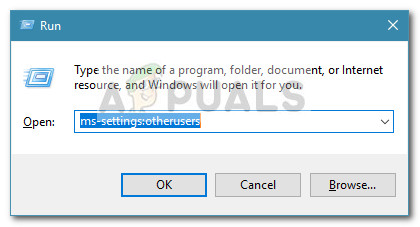
Open up the Other Users tab - After selecting the Family & other users tab, click Add someone else to this PC on the Other users tab.
- After that, provide the phone number and email you want to link to your Microsoft account.
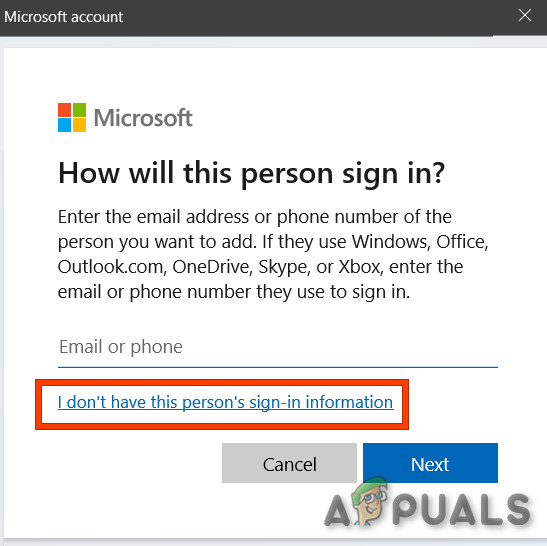
Don’t have this person sign in Please take note: Select I don’t know this person’s sign-in information if you wish to create a local account.
- After doing this, you will be asked to enter a username and password for the new administrator account you want to establish. Click Next at the next prompt.
Note: For backup purposes, you might also need to set up a few security questions. - Return to the Family & Other People window after the new account has been established, find it, and select Change Account type.
- Select Administrator from the drop-down menu in the Change account type window, then click Ok to save the changes and make the newly created account an administrator.
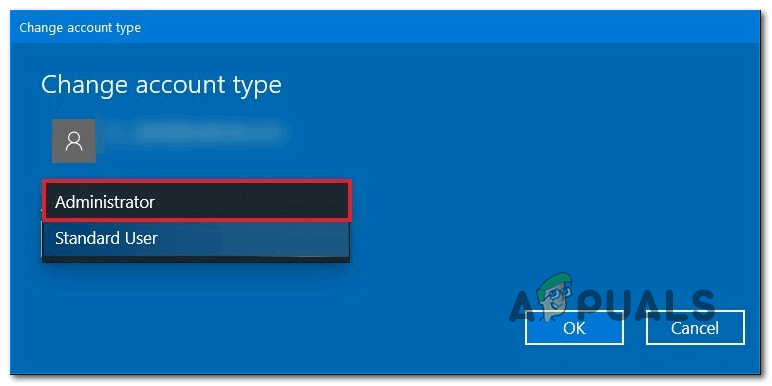
Changing the account type - Restart your computer, then sign in at the following sign-up screen using the newly created admin account.
- After your computer has restarted, try to uninstall the Microsoft Store application once more to check if the issue has been resolved.
If you prefer the terminal approach (a bit more technical but shorter), follow the sub-guide below.
5.2. Create a new admin account via CMD
You won’t be able to establish an administrator account through the Settings menu if you’re using an older version of Windows. The simplest method in this situation is to execute it from an elevated Command Prompt.
How to do it is as follows:
- To enter the Run dialog box, first click Windows key + R.
- To open an elevated Command prompt, type “cmd” into the text box and hit Ctrl + Shift + Enter.
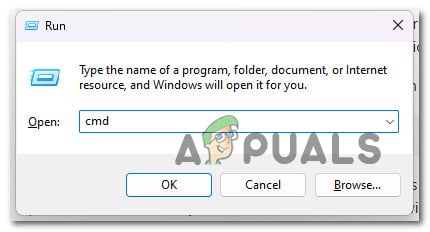
Open a CMD window Note: Click Yes to grant admin access when you reach the UAC (User Account Control).
- To establish a new Windows account and grant it admin permissions, execute the following commands into the elevated Command Prompt window and hit Enter after each one:
net user /add ReplaceME new localgroup administrators ReplaceME /add
Note: The placeholder *ReplaceMe* should be changed to the name of the new Windows account you want to establish.
- After the two commands have been executed, end the elevated CMD window, restart your computer, and log into the new admin account before trying to delete the software once more.
Continue to the next possible solution below if the same problem persists even after you successfully generated a new administrator account.
6. Delete the demo version of the game (if applicable)
It turns out that if you are attempting to remove a sample of a game that you already own, you might anticipate running into this specific version. It is a bug in the Microsoft Store that makes it impossible for you to uninstall it.
However, you can get around it by finding the game demo’s location and deleting it there by hand.
If you installed the demo via Microsoft Store the fix is easy since they all have the same location.
Follow the instructions below to learn how to do this:
- Press Windows key + E to open up File Explorer.
- Next, use File Explorer to navigate to the following location:
C:\Program Files\WindowsApps
Note: This guide assumes that your C drive is the Windows drive. If your particular situation is different, adapt the path above.
- Once you arrive in the correct location, locate the game demo, right-click on it and choose Delete to get rid of the entire folder.
Important: Make sure the the game is closed before attempting the deletion operation. - After the demo folder is deleted, reboot your PC and see if the title has disappeared from Microsoft Store the next time you open it.
If this scenario was not applicable to your situation, move down to the next method below.
7. Remove the W10 packages via Powershell (if applicable)
If you get this error while attempting to uninstall W10 packages from your Windows 11 computer via Powershell, you should double-check your syntax. We’ve provided the full instructions on how to uninstall unnecessary W10 packages via an elevated Powershell terminal.
Here’s what you need to do in case this scenario is applicable:
- Press Windows key + R to open up a Run dialog box.
- Next, type ‘powershell’ inside the text box, then press Ctrl + Shift + Enter to open up an elevated Powerhsell window.

Access an elevated powershell window - At the User Account Control (UAC), click Yes to grant admin access.
- Once you’re inside the elevated Powershell terminal, run the following commands in the same order to effectively remove the W10 packages:
Set-ExecutionPolicy Unrestricted Get-AppXPackage -AllUsers | Foreach {Add-AppxPackage -DisableDevelopmentMode -Register "$($_.InstallLocation)\AppXManifest.xml"} Remove-AppxPackage Microsoft.WindowsStore_8wekyb3d8bbwe - Once every command is processed successfully, reboot your PC and see if the problem is now resolved.
If this method was not applicable, move down to the next method below.
8. Deploy SFC & DISM scans
Your Windows PC likely has some sort of system file damage related to the UWP installer if you’ve come to this method without finding a solution.
The next action should be to launch DISM (Deployment Image Servicing and Management) and SFC (System File Checker) – two built-in programs that can address the most frequent causes of system file corruption.
Although SFC and DISM essentially serve the same purpose, it is more probable that the corruption problem will be resolved if they are done directly following one another.
It should be noted that while SFC gets healthy system files from a local area, DISM obtains files via Windows Update in order to replace faulty counterparts.
By using an elevated CMD prompt, you may conduct an SFC scan to look for system file corruption.
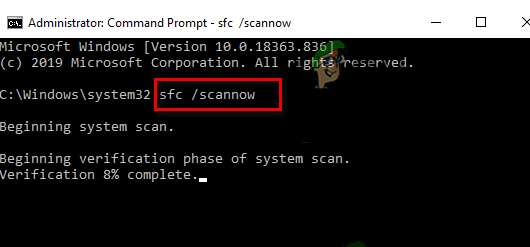
IMPORTANT: Even if the instrument appears to have frozen in the middle of use, it is preferable to carry on with this procedure (or prematurely quit the CMD window). The success notification will eventually be sent to you once the transaction is complete.
The DISM scan will end once your machine has restarted. After the subsequent startup is complete, perform a DISM scan.

IMPORTANT: Before starting this step, check the strength of your Internet connection.
Restart your computer to see if the problem has been fixed after appropriately executing the DISM command.
If the problem is still not solved, proceed to the method below.
9. Perform a repair install or clean install
If none of the aforementioned techniques have helped you, your only remaining option is to entirely replace all of the impacted system file dependencies with healthy replacements.
At this point, your only choices are to perform a clean install or a repair install (in-place upgrade).
If you encounter issues, we strongly advise selecting an in-place update (repair installation) if you have a choice:
- Repair install (in-place upgrade) – Only the system files will be changed during a repair install (while keeping your personal files, user preferences apps & games).
- Clean install – This choice might be the best if only a small number of kernel processes are impacted, but it has the disadvantage of wiping out all user data from the OS disk. Nevertheless, you should be aware that if you do this, all of your personal data will be erased.




